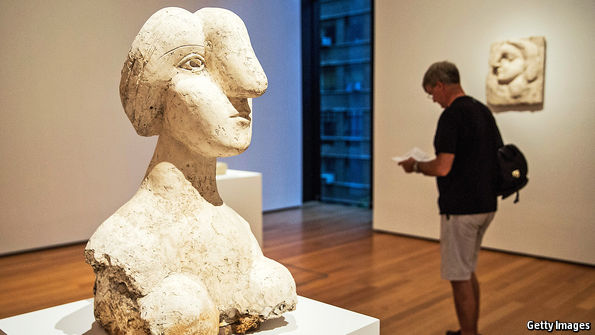Picasso, the sculptor
Master of surprises
Why the Spanish artist was as inspiring a sculptor as he was a painter

From the print edition
.| Books and artsSep 26th 2015| NEW YORK
Why the Spanish artist was as inspiring a sculptor as he was a painter

From the print edition
.| Books and artsSep 26th 2015| NEW YORK
IN 1971 the 90-year-old Pablo Picasso described a catalogue of his sculpture as the chronicle of “an unknown civilisation”. The mystery was mostly of his own making. Trained as a painter, he turned to sculpture from an inner compulsion, using the medium to explore the deeper reaches of his psyche, but keeping the results largely hidden from public view.
These works were usually improvisational, radically experimental and endowed by their creator with an almost fetishistic power. Hence his refusal to lend any of his sculptures to “Picasso: A 75th Anniversary Exhibition” that the Museum of Modern Art (MoMA) in New York put on in 1957. He hated to part, even temporarily, with these totems of his own devising. As recently as 2000, a retrospective at the Centre Pompidou in Paris still maintained that Picasso’s sculptures were the “best kept secret of the 20th century”.
Latest updates
Whereas the public remained more-or-less unaware of Picasso’s sculptural achievement, artists had long been in on the secret. When Umberto Boccioni first saw Picasso’s faceted Cubist “Head of a Woman” (1909)—one of the few early sculptures to be displayed in a gallery—he suddenly saw how to infuse static form with Futurist dynamism, conveying a sense of the figure opening up in space and moving through time. In 1914 Vladimir Tatlin, a Ukrainian-born artist and architect, paid a visit to Picasso’s studio where he recalled seeing a “violin sawn up into pieces, hanging by threads on various planes.” Returning to Russia, he radically transformed how he worked. Alberto Giacometti and Marcel Duchamp also learned vital lessons from Picasso’s sculptures.
One of the most exhilarating aspects of “Picasso Sculpture”, a new show that has just opened at MoMA, is to see with what nonchalance he manages to overturn millennia of artistic practice. Nothing in his earliest work—bronze figures sensitively modelled but traditionally conceived, or primitive totems crudely hacked out of wood—prepares viewers for the subversive “Apple” (1909), a modest form of carved plaster in which the fruit has been invested with an unexpected monumentality through cubist faceting. Not only does this humble object upend traditional distinctions between solid and void, surface and interior, but it overturns centuries of artistic tradition in which the human figure was deemed to be the only subject worthy of the sculptor’s attention.
Even more ground-breaking are the constructed sculptures Picasso made a few years later from studio scraps and found objects, beginning with the revolutionary “Still Life with Guitar” (1912), a work pieced together out of cardboard, wire, string and other junk. Made with the exuberance of a young child set loose with a pot of glue and pair of scissors, this jerry-rigged wall relief launched a revolution. Barely two feet tall, it is the humble ancestor to every monstrous welded metal assemblage bestriding today’s urban landscapes.
沒有留言:
張貼留言